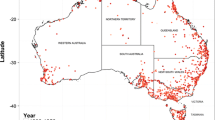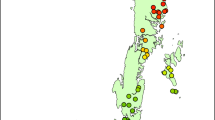Abstract
Management of invasive species has increasingly emphasized the importance of early detection and rapid response (EDRR) programs in limiting introductions, establishment, and impacts. These programs require an understanding of vector and species spatial dynamics to prioritize monitoring sites and efficiently allocate resources. Yet managers often lack the empirical data necessary to make these decisions. We developed an empirical mapping tool that can facilitate development of EDRR programs through identifying high-risk locations, particularly within the recreational boating vector. We demonstrated the utility of this tool in the Great Lakes watershed. We surveyed boaters to identify trips among water bodies and to quantify behaviors associated with high likelihood of species transfer (e.g., not removing organic materials from boat trailers) during that trip. We mapped water bodies with high-risk inbound and outbound boater movements using ArcGIS. We also tested for differences in high-risk behaviors based on demographic variables to understand risk differences among boater groups. Incorporation of boater behavior led to identification of additional high-risk water bodies compared to using the number of trips alone. Therefore, the number of trips itself may not fully reflect the likelihood of invasion. This tool can be broadly applied in other geographic contexts and with different taxa, and can be adjusted according to varying levels of information concerning the vector or species of interest. The methodology is straightforward and can be followed after a basic introduction to ArcGIS software. The visual nature of the mapping tool will facilitate site prioritization by managers and stakeholders from diverse backgrounds.


Similar content being viewed by others
References
Acosta H, Wu D, Forrest BM (2010) Fuzzy experts on recreational vessels, a risk modelling approach for marine invasions. Ecol Model 221:850–863
ANS Task Force (2013) Stop aquatic hitchhikers. http://www.protectyourwaters.net. Accessed 28 Apr 2014
Bossenbroek JM, Kraft CE, Nekola JC (2001) Prediction of long-distance dispersal using gravity models: zebra mussel invasion of inland lakes. Ecol Appl 11:1778–1788
Bossenbroek JM, Johnson LE, Peters B, Lodge DM (2007) Forecasting the expansion of zebra mussels in the United States. Conserv Biol 21:800–810
Buchan LAJ, Padilla DK (1999) Estimating the probability of long-distance overland dispersal of invading aquatic species. Ecol Appl 9:254–265
Burgin S, Hardiman N (2011) The direct physical, chemical and biotic impacts on Australian coastal waters due to recreational boating. Biodivers Conserv 20:683–701
Catling PM, Spicer KW, Lefkovitch LP (1988) Effects of the introduced floating vascular aquatic Hydrocharis morsus-ranae Hydrocharitaceae on some North American aquatic macrophytes. Nat Can 115:131–138
Chivers C, Leung B (2012) Predicting invasions: alternative models of human-mediated dispersal and interactions between dispersal network structure and Allee effects. J Appl Ecol 49:1113–1123
Cilliers C, Zeller D, Strydom G (1996) Short- and long-term control of water lettuce (Pistia stratiotes) on seasonal water bodies and on a river system in the Kruger National Park, South Africa. Hydrobiologia 340:173–179
Clarke Murray C, Pakhomov EA, Therriault TW (2011) Recreational boating: a large unregulated vector transporting marine invasive species. Divers Distrib 17:1161–1172
Compton TJ, De Winton M, Leathwick JR, Wadhwa S (2012) Predicting spread of invasive macrophytes in New Zealand lakes using indirect measures of human accessibility. Freshwater Biol 57:938–948
Dalton LB, Cottrell S (2013) Quagga and zebra mussel risk via veliger transfer by overland hauled boats. Manage Biol Invasions 4:129–133
Darbyson E, Locke A, Hanson JM, Willison JHM (2009) Marine boating habits and the potential for spread of invasive species in the Gulf of St. Lawrence. Aquat Invasions 4:87–94
Drury KLS, Rothlisberger JD (2008) Offense and defense in landscape-level invasion control. Oikos 117:182–190
Greiner H, Kashian D, Tiegs S (2012) Impacts of invasive Asian (Amynthas hilgendorfi) and European (Lumbricus rubellus) earthworms in a North American temperate deciduous forest. Biol Invasions 14:2017–2027
Jerde CL, Barnes MA, DeBuysser EK, Noveroske A, Chadderton WL, Lodge DM (2012) Eurasian watermilfoil fitness loss and invasion potential following desiccation during simulated overland transport. Aquat Invasions 7:135–142
Johnson LE, Ricciardi A, Carlton JT (2001) Overland dispersal of aquatic invasive species: a risk assessment of transient recreational boating. Ecol Appl 11:1789–1799
Johnson L, Bossenbroek J, Kraft C (2006) Patterns and pathways in the post-establishment spread of non-indigenous aquatic species: the slowing invasion of North American inland lakes by the zebra mussel. Biol Invasions 8:475–489
Johnstone IM, Coffey BT, Howard-Williams C (1985) The role of recreational boat traffic in interlake dispersal of macrophytes: a New Zealand case study. J Environ Manage 20:263–279
Keller RP, Cox AN, Van Loon C, Lodge DM, Herborg L-M, Rothlisberger J (2007) From bait shops to the forest floor: earthworm use and disposal by anglers. Am Midl Nat 158:321–328
Keller RP, Frang K, Lodge DM (2008) Preventing the spread of invasive species: economic benefits of intervention guided by ecological predictions. Conserv Biol 22:80–88
Larson ER, Olden JD (2008) Do schools and golf courses represent emerging pathways for crayfish invasions? Aquat Invasions 3:465–468
Larson DL, Phillips-Mao L, Quiram G, Sharpe L, Stark R, Sugita S, Weiler A (2011) A framework for sustainable invasive species management: environmental, social, and economic objectives. J Environ Manage 92:14–22
Lee J, Oh C-O, O’Keefe D (2012) Boaters’ knowledge, preferences and actions associated with effective boating practices for the prevention of aquatic nuisance species: Michigan ANS and boating survey final report. Michigan State University and Michigan Sea Grant. http://www.miseagrant.umich.edu/files/2012/08/12-205-ANS-Boating-Survey-Report.pdf. Accessed 4 Apr 2015
Litvak MK, Mandrak NE (1993) Ecology of freshwater baitfish use in Canada and the United States. Fisheries 18:6–13
Ludwig HR, Leitch JA (1996) Interbasin transfer of aquatic biota via anglers’ bait buckets. Fisheries 21:14–18
MacIsaac HJ, Borbely JVM, Muirhead JR, Graniero PA (2004) Backcasting and forecasting biological invasions of inland lakes. Ecol Appl 14:773–783
McLafferty S (2010) Placing pandemics: geographical dimensions of vulnerability and spread. Eurasian Geogr Econ 51:143–161
Muirhead JR, Macisaac HJ (2005) Development of inland lakes as hubs in an invasion network. J Appl Ecol 42:80–90
National Marine Manufacturers Association (2010) 2010 U.S. Recreational Boat Registration Statistics. http://www.nmma.org/news.aspx?id=18028. Accessed 4 Apr 2015
Padilla DK, Chotkowski MA, Buchan LAJ (1996) Predicting the spread of zebra mussels (Dreissena polymorpha) to inland waters using boater movement patterns. Glob Ecol Biogeogr Lett 5:353–359
Reed-Andersen T, Bennett EM, Jorgensen BS, Lauster G, Lewis DB, Nowacek D, Riera JL, Sanderson BL, Stedman R (2000) Distribution of recreational boating across lakes: do landscape variables affect recreational use? Freshwater Biol 43:439–448
Richey H (2004) Reproduction of the exotic estuarine mud crab Rhithropanopeus harrisii in Texas impoundments. M.Sc. dissertation, Tarleton State University
Rothlisberger JD, Lodge DM (2011) Limitations of gravity models in predicting the spread of Eurasian watermilfoil. Conserv Biol 25:64–72
Rothlisberger JD, Chadderton WL, McNulty J, Lodge DM (2010) Aquatic invasive species transport via trailered boats: what is being moved, who is moving it, and what can be done. Fisheries 35:121–132
Rup MP, Bailey SA, Wiley CJ, Minton MS, Miller AW, Ruiz GM, MacIsaac HJ (2010) Domestic ballast operations on the Great Lakes: potential importance of Lakers as a vector for introduction and spread of nonindigenous species. Can J Fisheries Aquat Sci 67:256–268
Timar L, Phaneuf DJ (2009) Modeling the human-induced spread of an aquatic invasive: the case of the zebra mussel. Ecol Econ 68:3060–3071
Tøttrup AP, Chan BKK, Koskinen H, Høeg JT (2010) ‘Flying barnacles’: implications for the spread of non-indigenous species. Biofouling 26:577–582
U.K. Department of the Environment (2013) An invasive alien species strategy for Northern Ireland. http://www.doeni.gov.uk/invasive_species_2013_4-_web.pdf. Accessed 4 Apr 2015
U.S. Department of the Interior, U.S. Fish and Wildlife Service, U.S. Department of Commerce, U.S. Census Bureau (2011) National survey of fishing, hunting, and wildlife-associated recreation
Vander Zanden MJ, Hansen GJA, Higgins SN, Kornis MS (2010) A pound of prevention, plus a pound of cure: early detection and eradication of invasive species in the Laurentian Great Lakes. J Great Lakes Res 36:199–205
Villamagna AM, Murphy BR (2010) Ecological and socio-economic impacts of invasive water hyacinth (Eichhornia crassipes): a review. Freshw Biol 55:282–298
Wasson K, Zabin CJ, Bedinger L, Cristina Diaz M, Pearse JS (2001) Biological invasions of estuaries without international shipping: the importance of intraregional transport. Biol Conserv 102:143–153
Westbrooks RG (2004) New approaches for early detection and rapid response to invasive plants in the United States. Weed Technol 18:1468–1471
Wimbush J, Frischer ME, Zarzynski JW, Nierzwicki-Bauer SA (2009) Eradication of colonizing populations of zebra mussels (Dreissena polymorpha) by early detection and SCUBA removal: Lake George, NY. Aquat Conserv 19:703–713
Zhang C, Boyle KJ (2010) The effect of an aquatic invasive species (Eurasian watermilfoil) on lakefront property values. Ecol Econ 70:394–404
Acknowledgments
This paper is a result of work sponsored by the U.S. Environmental Protection Agency Grant GLOOE01152-0. We thank Michigan Sea Grant and the U.S. National Oceanic and Atmospheric Administration Weather Service and the boat show organizers for assistance at the boat shows. We thank the Michigan DNR and Department of Environmental Quality, the Secretary of State, Michigan and Ohio Sea Grant our advisory board, Heather Siersma and F. Gianluca Sperone, U.S. National Oceanic and Atmospheric Administration/Great Lakes Environmental Research Laboratory, Jake Dombroski, and Cody Narlock. In addition, we thank our volunteers Carly Nowicki, Joseph Canaday, Jessica White, Erica Volansky, Sara Saymuah, Viviana Veber, Karima Alwakya, Ben Davidson, Karim Alame, George Fakhouri, Aimee Faloppa, Thomas Schumacker, Jenna Merlo, Amy Benchich, and Sarah Corral.
Conflict of Interest
The authors declare that they have no conflict of interest.
Ethical Standards
All experiments comply with the current laws of the country in which they were performed.
Author information
Authors and Affiliations
Corresponding author
Electronic supplementary material
Below is the link to the electronic supplementary material.
Rights and permissions
About this article
Cite this article
Davidson, A.D., Fusaro, A.J. & Kashian, D.R. Using a Novel Spatial Tool to Inform Invasive Species Early Detection and Rapid Response Efforts. Environmental Management 56, 54–65 (2015). https://doi.org/10.1007/s00267-015-0484-2
Received:
Accepted:
Published:
Issue Date:
DOI: https://doi.org/10.1007/s00267-015-0484-2




